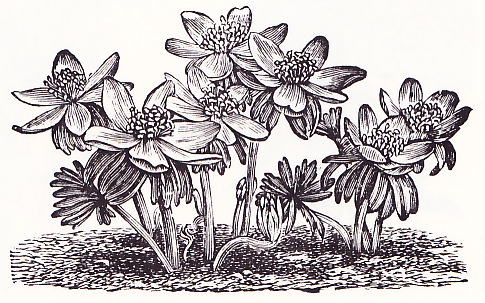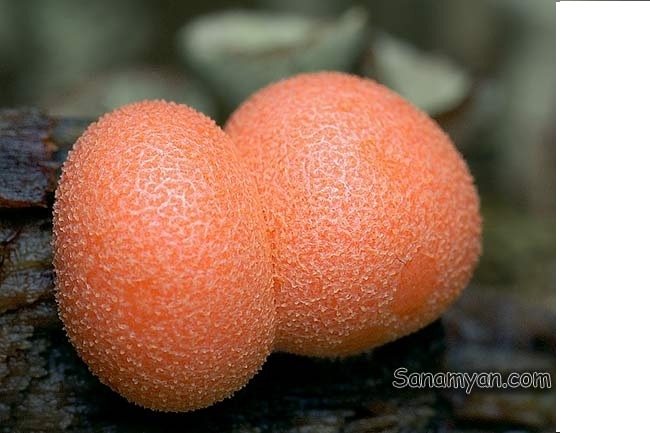wall-rocket n. any herb of the genus Diplotaxis DC. (of the Brassicaceae), upright ruderals bearing pinnatifid leaves, yellow flowers, and oblong siliques in fruit, and frequently growing adjacent to walls or cliffs.
wandering Jew n. any of a number of tough houseplants which do not easily die from maltreatment, including Tradescantia albiflora Kunth, T. pallida (Rose) D.R.Hunt, or T. zebrina Bosse, (all of the Commelinaceae) or any of the many species of Pilea Lindl. (of the Urticaceae), and these all tend to be somewhat succulent herbs bearing leaves with interesting markings or textures. [< a medieval legend about a Jew who struck Jesus on his way to the crucifixion, but probably deriving in turn from a misunderstanding about the fugitive lifestyle of Jews who no longer had a homeland of their own]
water-dropwort n. any of a number of erect herbs (species of Oenanthe L., of the Apiaceae) with somewhat ridged stems, twice- or thrice-pinnate leaves bearing pinnæ varying greatly among the species, and flat-topped or globular compound umbels of white flowers. These tend to grow in low meadows or along ponds or flowing water, or by the sea, and are found in Europe and India.
water pick n. a plastic tube, closed at one end with a flexible membrane and at the other with a hard barbed conical tip, which may be used to fix cut flowers in floral foam with a water supply, and for use in flower arrangements.
water-purslane n. a creeping annual herb native to Europe (Peplis portula L., of the Lythraceae), which grows on inundated ground and bears opposite ovate leaves with tiny solitary flowers in their axils.
water-shield n. an aquatic perennial herb bearing natant peltate leaves from rooted rhizomes (Brasenia schreberi J.F.Gmel., of the Cabombaceae), native to the Americas and also to eastern Asia, Africa, Australia, and India (although probably introduced to some of these). It is distinctive for bearing its small purple flowers over two days (the first day functionally female, the second day male), and for bearing mucilage over all its submerged surfaces. [descriptive of the leaves]
water tube n. a plastic tube, closed at one end and with a flexible membrane at the other, which may be used to provide cut flowers with a water supply, and for use in flower arrangements.
wax myrtle n. any of several species of bayberry, especially those producing useful accumulations of wax upon their drupes (in particular the North American Myrica cerifera L., of the Myricaceae). The wax is used to fabricate aromatic candles.
wax·y (wak´sē) adj. wax·i·er, wax·i·est. 1 having a consistency or texture due to wax extrusions. 2 having an overall appearance of being formed of wax. —wax´i·ness, n.
weeping willow n. vernacular name for either a widespread hybrid willow (Salix × fragilis L., of the Salicaceae, derived from the European and boreal Asian S. alba L. and S. euxina I.V.Belyaeva), or the closely-related S. babylonica L., both noted for their brittle pendant branches reaching nearly to the ground; crack-willow.
white alder n. 1 many species of a genus of shrubs and small trees (Clethra L., of the Clethraceae), in a variety of temperate and tropical habitats, in eastern Asia, the Americas, and one species in Madeira and the Canary Islands. They bear alternate deciduous leaves and terminal panicles of attractive fragrant bell-shaped flowers. 2 a tree species of alder (Alnus rhombifolia Nutt., of the Betulaceae), native to a restricted range in western alpine North America, bearing leaves which are really more ovate than rhombic, and catkins which disperse seeds during winter.
white nun orchid n. a relatively-large white orchid which is the national flower of Guatemala (Lycaste virginalis (Scheidw.) Linden f. alba (Dombrain) Archila & Chiron, of the Orchidaceae), and grows at moderate altitudes in Central America. [< Sp. monja blanca]
white pepper n. a condiment prepared from entire dried berries of Piper nigrum L. (of the Piperaceae), using peppercorns which ripen on the plant and are therefore slightly less piquant than the black ones.
white potherb n. an edible herb (Valerianella locusta (L.) Laterr., of the Valerianaceae), native to Europe and western Asia, and consisting of a dark-green rosette of spatulate leaves; corn-salad; rapunzel.
wild (wīld) adj. wild·er, wild·est. 1 of an organism: living and growing in nature, without human cultivation of any kind. 2 of a landscape or other habitat: natural and unrestrained, resulting from or pertaining to intrinsic capacities of organisms to establish and grow in a conducive environment. 3 of a storm or other event: approaching a natural local extreme of possible variation; extreme. —n. usually, in the wild or wilds, of or pertaining to a natural community, or growth in such a community, usually at a distance from civilization. —v.phr. go wild, begin unrestrained growth, or behave in uncharacteristic ways. —v.phr. run wild, begin and proceed upon unrestrained growth and/or reproduction, or the overtaking of a community by such growth. [< OE wilde < Gmc.] —wild´ly, adv. —wild´ness, n.
wild·ing (wīl´ding) n. 1 any wild plant descended from cultivated crop plants, and used especially of apple trees; wildling. 2 the fruit of such a plant. [< ME wild + ing]
wild·ling (wīld´ling) n. wilding.
wilt (wilt) v.i. n. —v.i. of an organ or an individual, become flaccid due to loss of turgor pressure. —n. 1 the action of wilting. 2 any of a range of fungal or bacterial diseases of plants, which induce wilting. [originally dialectic; ? < LG wilk, welk]
wind·flow·er (wind´flou´ər) n. any of various species of Anemone L. (of the Ranunculaceae), low herbs with showy white solitary flowers, producing plumed seeds. [< Gk. anemṓnē ἀνεμώνη, ? < anemos ἄνεμος wind]
wind·throw (wind´thrō´) n. 1 a tree which has been knocked to the ground by wind. 2 Rare. a single individual, or many, of a crop species which has or have been similarly knocked to the ground by wind. 3 the felling of a tree or trees by loss of stability under strong winds. This often results from exposure of shallow-rooted plants on the edge of a forest, or of especially tall individuals.
winter aconite n. the toxic European herb Eranthis hyemalis Salisb. (of the Ranunculaceae), which bears bright yellow actinomorphic flowers in early spring, and grows from a stout rhizome.
witch (wich) adj., comb.form., prefix. wych-. [< ME wice, wich, wych < OE wice pliant < Gmc.]
wolf·ber·ry (wu̇lf´bãr´ē) n. -ries. 1 either of two subshrubs native to temperate Asia (Lycium barbarum L. and/or L. chinense Mill., both of the Solanaceae), bearing elliptical or ovate leaves and bright orange-red oblong berries; goji; tomatillo. 2 a low shrub native to north temperate North America (Symphoricarpos occidentalis Hook., of the Caprifoliaceae), bearing opposite ovate leaves, pinkish 5-merous flowers whose stamens bear hairy filaments, and spherical white edible drupes.
wolf’s-milk n. 1 a spurge, particularly the northern Eurasian Euphorbia helioscopia L. (of the Euphorbiaceae), due to its acrid latex; sun-spurge. 2 a myxomycete of the genus Lycogala L (especially the northern European L. epidendrum L., of divisio Myxomycota), due to its often milky-coloured fruiting bodies. [< MLG wulfsmelk]
wolf·wort (wu̇lf´wôrt´) n. 1 any of several plants in the genus Aconitum Tourn. ex L. (of the Ranunculaceae); wolfsbane. 2 a plant of the Eurasian genus Periploca Tourn. ex L. (of the Asclepiadaceae), whose juice was used for the poisoning of wolves. [ME]
wood-ear (wu̇d´ēr´) n. an edible fungus (Auricularia auricula-judae St.-Amans, of the Basidiomycota), native to North America and Europe, which produces gelatinous tan-brown auriculate basidiomata upon the exposed trunk and branches of certain trees, especially elder. The fruiting body of this species ordinarily consists solely of a pileus.
worm grass n. 1 either of two herbs native to the Americas (Spigelia anthelmia L. and S. marilandica (L.) L., both of the Loganiaceae), and both possessing vermifuge properties; pinkroot. 2 a small stonecrop (Sedum album L., of the Crassulaceae), reputed to have vermifuge properties. It was native to northern Eurasia, but is now cosmopolitan.
wound·wort (wünd´wôrt) n. any herb of the largely Eurasian genus Stachys L. (of the Lamiaceae), bearing an intermittent terminal spike of floral whorls, the bilabiate flowers characterised by a concave upper lip and trilobate lower lip with the central lobe elongate. The genus is in general very similar to betony, but more hirsute. [popular in use as a medicinal herb among the Anglo-Saxons]


